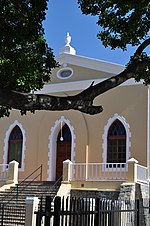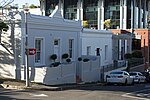Tana Baru Cemetery
Cape TownCemeteries in South Africa

The Tana Baru Cemetery is a Muslim cemetery where some of the earliest and respected Muslim settlers of South Africa were buried. The cemetery is located in Bo-kaap, Cape Town. After religious freedom was granted to Muslims in 1804, the Batavian government assigned the first piece of land for use as a Muslim cemetery. It was called Tana Baru, meaning, New Ground. The Tana Baru is currently closed for use, but has always been regarded as the most hallowed of Muslim cemeteries in Cape Town. Within the cemetery is buried three prominent early Cape Muslim Imams, namely, Tuan Nuruman, Tuan Sayeed Alawse and Tuan Guru along with shrines erected to honour them.
Excerpt from the Wikipedia article Tana Baru Cemetery (License: CC BY-SA 3.0, Authors, Images).Tana Baru Cemetery
Dawes Street, Cape Town Bo-Kaap
Geographical coordinates (GPS) Address Nearby Places Show on map
Geographical coordinates (GPS)
| Latitude | Longitude |
|---|---|
| N -33.918611111111 ° | E 18.415 ° |
Address
Dawes Street
Dawes Street
8051 Cape Town, Bo-Kaap
Western Cape, South Africa
Open on Google Maps










